This weekend we saw the final matchday of the season in the Austrian Bundesliga. In Austria’s highest division one team get relegated at the end of the season to the second tier. Ahead of this weekend, WSG Tirol sat in the 12th and last position with 15 points while Admira were ahead of them with 17 points. Since Mattersburg already collected 21 points, it was clear that the direct clash between WSG Tirol and Admira would decide which team would go down. In the light of this, the side of Thoams Silberberger needed the three points to stay in the Austrian Bundesliga and Admira wanted to avoid that.
In this tactical analysis, we will talk about the tactics of WSG Tirol and Admira and additionally outline the reasons why this important clash in the relegation battle ended 0-0 which means that WSG Tirol will play in the second Austrian division.
Lineups
The home team went with their usual 4-4-2 formation, with the captain Ferdinand Oswald between the sticks. The back four was made out of Florian Buchacher, David Gugganig, Bruno Soares and Sandro Neurauter. Thanos Petsos and Michael Svoboda were the central midfielders and Clemens Walch provided width together with Dino Kovačec. Upfront the two strikers were Stefan Maierhofer and Zlatko Dedič.
On the other side, Zvonimir Soldo lined his team up in a 4-1-4-1 formation. Andreas Leitner was the goalkeeper, and in front of him, he had four defenders in Marcus Maier, Christoph Schösswendter, Emanuel Aiwu and Pascal Petlach. Markus Lackner was the defensive midfielder and was supported in the middle of the pitch by the Norwegian Morten Hjulmand and Roman Kerschbaum. Erwin Hoffer and Muhammed-Cham Saracevic were the wingers and Markus Pink was the central striker.
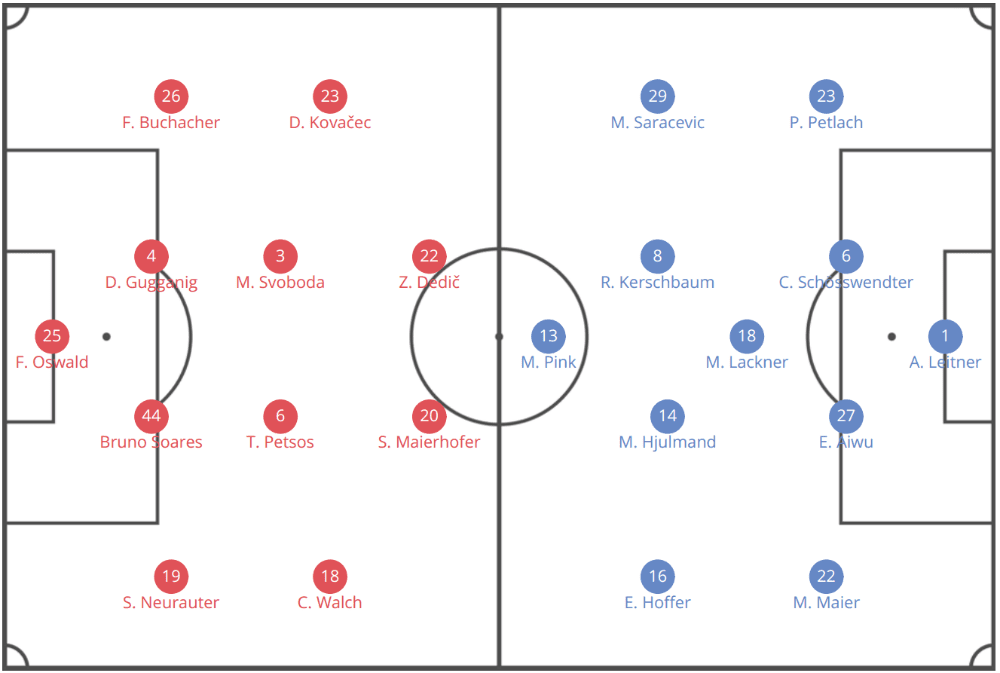
Tirol’s idea in possession
Even though the game ended 0-0, we saw throughout the game several chances and especially WSG Tirol missed some huge goalscoring opportunities. They were the team which dominated possession, while Admira mostly sat back deeper and started to put pressure on the ball-carrier of Tirol, at about the height of the half-way line or occasionally a few yards higher.
In this first part of this tactical analysis, we will look at the tactics and basic idea of WSG Tirol, and additionally discuss the defensive behaviour of Admira. In the second section, we will have a more detailed look at the different roles of Dedič and Maierhofer, while in the last paragraph I’ll outline the reasons why Admira were quite weak offensively in this match.
Basically, the 4-4-2 of WSG Tirol transformed into a kind of a 4-2-2-2 since the two wingers tucked in as we will see later in this tactical analysis. The full-backs stayed during the first phase of the build-up deeper to be near the centre-backs and help them to circulate the ball, but then had the permission to push forward since the wings were vacated due to the central positioning of Walch and Kovačec.
Meanwhile, Petsos was the central midfielder who stayed deeper to help his teammates during the build-up, as he is incredibly good when it comes to the organisation of the build-up. Below we can see how the Greek is positioned near the centre-backs and Svoboda is already in a slightly higher area.
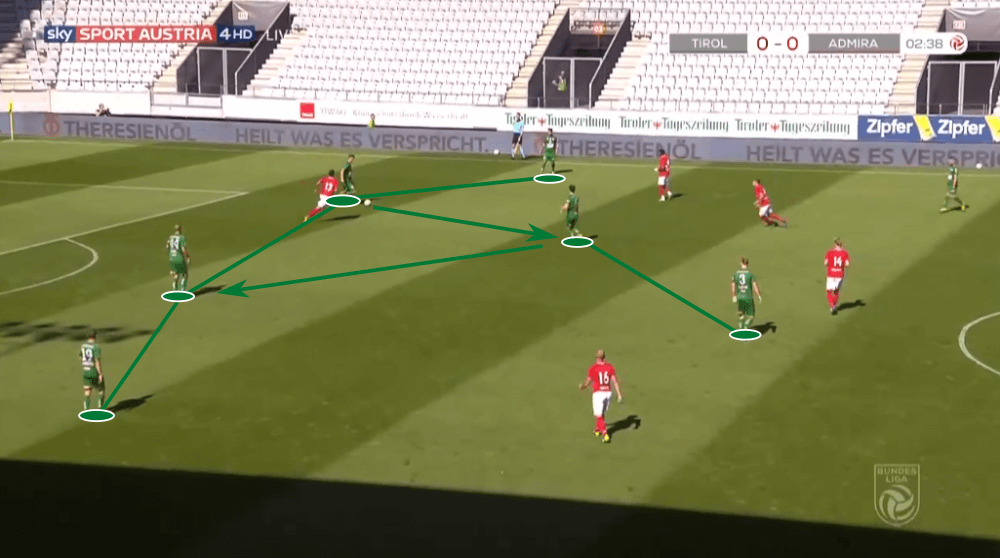
As already noted, Admira changed their pressing height as they mainly sat back deeper in a 4-1-4-1 or 4-5-1 as the wingers positioned quite deep, but especially in the first half they also sometimes decided to put pressure on WSG Tirol a bit higher up the pitch.
When they did so, we saw occasionally that Hjulmand had the task to follow Petsos and try to put him under some pressure. Therefore, the coach of Admira, Solda, had the plan that they would need to take Petsos out of the game when they pressed in at their opponents higher up the pitch. Below we can see an example as the Norwegian midfielder is positioned near Petsos and initiates the press.
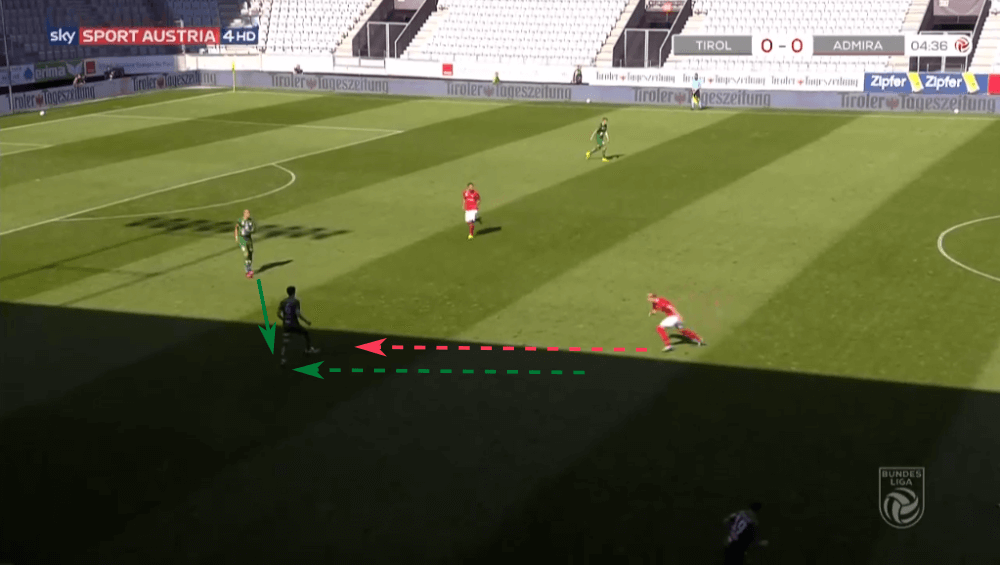
However, the Greek player quickly noticed that and understood that therefore he shouldn’t permanently drop, but also move to the wide-areas or make unorthodox positionings during the build-up. This helped his team massively, as it was due to his intelligent movements during the possession phase that he was often available for a passing option. In his heatmap for this match which is visualised below, we can see how much he worked for his team and that he was active in several areas of the pitch.
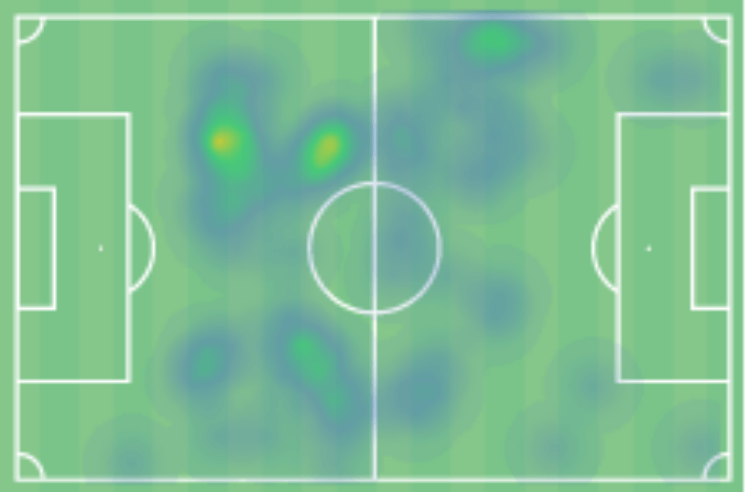
Now, we will shortly talk about the wingers of WSG Tirol. Walch got subbed off after about 30 minutes due to an injury and got replaced by Dominik Rieder. However, the basic task of the wingers stayed the same as they should position in the half-spaces between the lines for two reasons: They could receive their line-breaking passes and additionally WSG Tirol needed enough bodies in the centre to win the second balls, since their main tactical concept was to play long passes towards Maierhofer, who stands at 6’7”. Below we can see a situation in which both wingers are positioned centrally in their 4-4-2/4-2-2-2
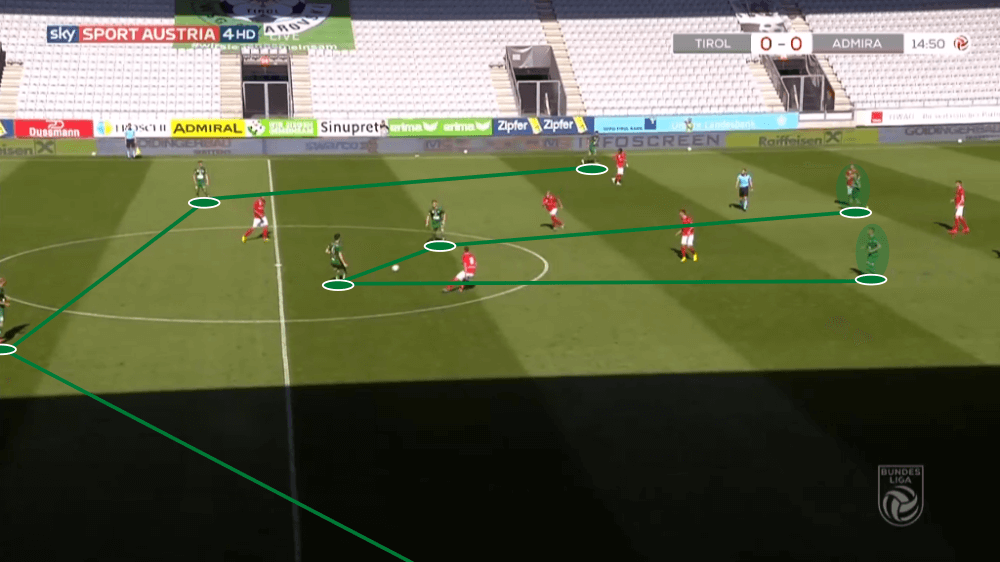
The two basic ideas of WSG Tirol to create goalscoring chances were either long balls towards the two strikers, who then should lay it off for either one and another or one of the wingers, or to reach the wide-areas to deliver crosses from there. Both tactical concepts worked quite well as they were able to create several big chances by using these ideas. Below, we have an example in which they were able to get their left-back Buchacher in a decent position, who then delivered a good cross towards Maierhofer, who was unable to score with a header.
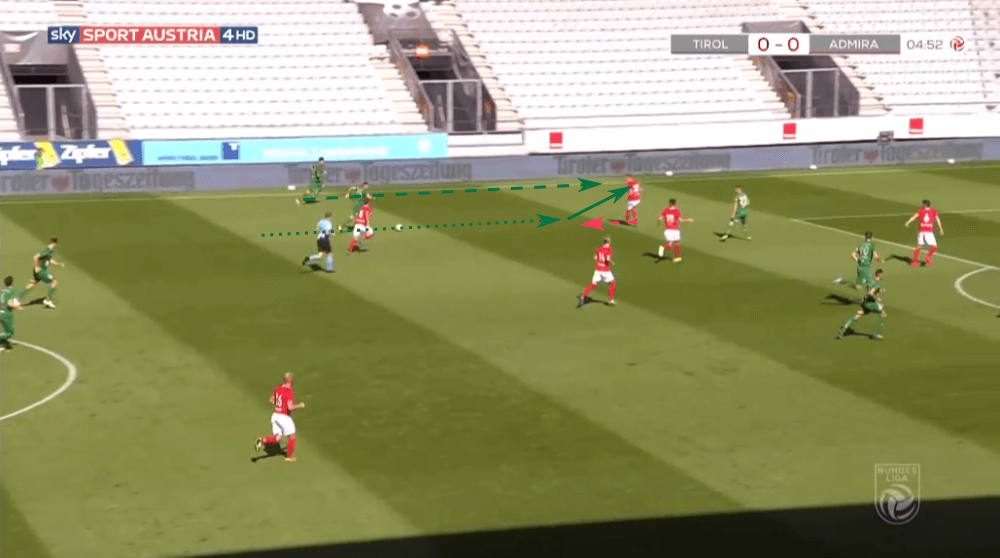
In general, Petsos was important for their progression while the passive defensive tactics helped Silberberger’s side to dominate the game. They preferred to get into the final third with the aid of long balls, for which the strikers were extremely important. We will focus on these two in the next section of this tactical analysis.
The roles of the two forwards
Maierhofer played throughout his career for several good clubs in the EPL (Wolves), EFL Championship (Millwall) and 2. Bundesliga (FC Cologne) and is now already 37 years old. Additionally, he was some kind of assistant coach and player at once during the final phase of this season. He and Dedič (35 years old) were the two strikers in this game and the greatest hope of WSG Tirol due to their experience and quality.
They were the central men in their team tactics since they were the targets for the long balls and also the crosses. However, Maierhofer and Dedič had quite different roles in this match as we will see in this part of the tactical analysis.
Maierhofer was the main target for Tirol’s long balls and had the objective to lay them off for his teammates. Therefore, he always stayed in the centre, so his teammates would know at any moment where to find him with long passes. As soon as he laid the ball off, he went into the penalty box. He had mainly Admira’s defensive midfielder Lackner against him, but won the majority of his aerial duels. In the example below, he controls the ball with his chest to then lay it off for Svoboda.
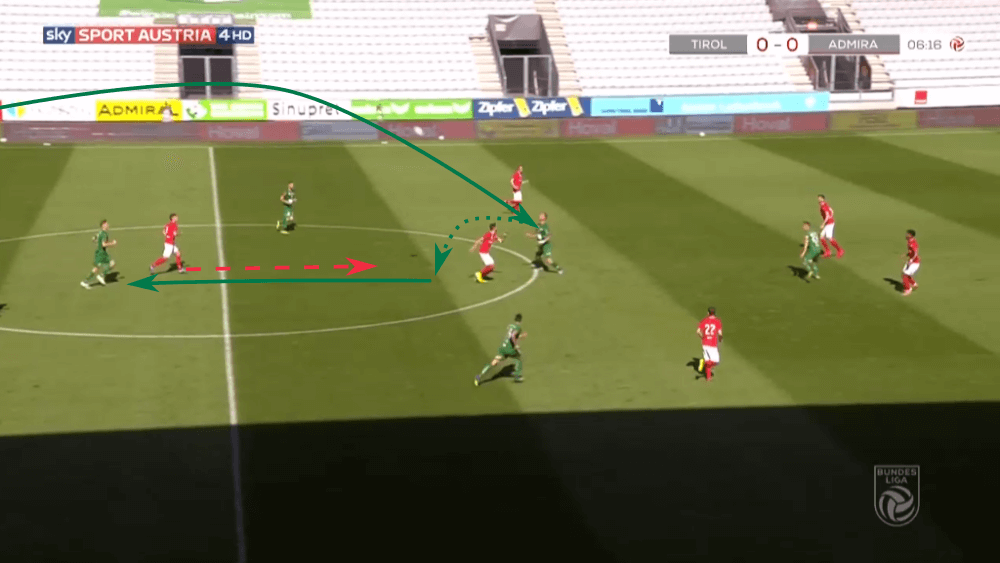
The aspect that he mainly stayed in the centre of the pitch to win the aerial duels and then enter the penalty area also gets visible by looking at his heatmap for this match which is illustrated below.
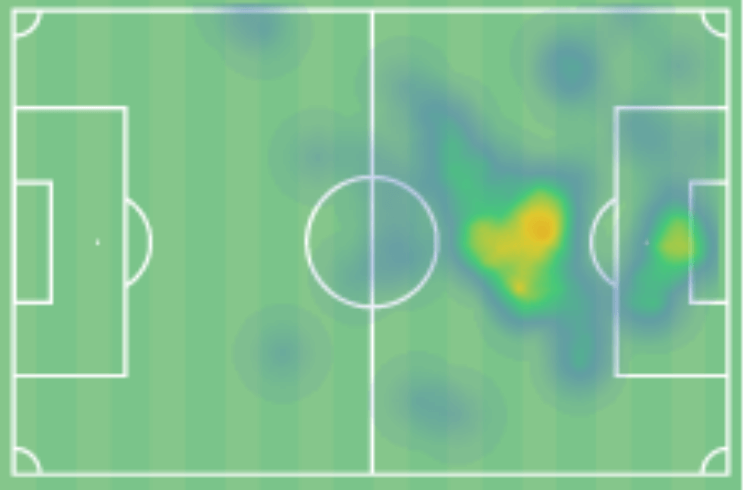
On the other side, Dedič had a different task, as he was to be near Maierhofer ahead of the aerial duels to win the second ball, or move into free spaces to provide a passing option for the deeper positioned teammates. He did quite well and was in general incredibly active in this match, as he permanently could be found all over the pitch as he tried to help his teammates. This can also be seen in his heatmap as he frequently drifted out to both half-spaces or wings to create space for himself or a teammate.
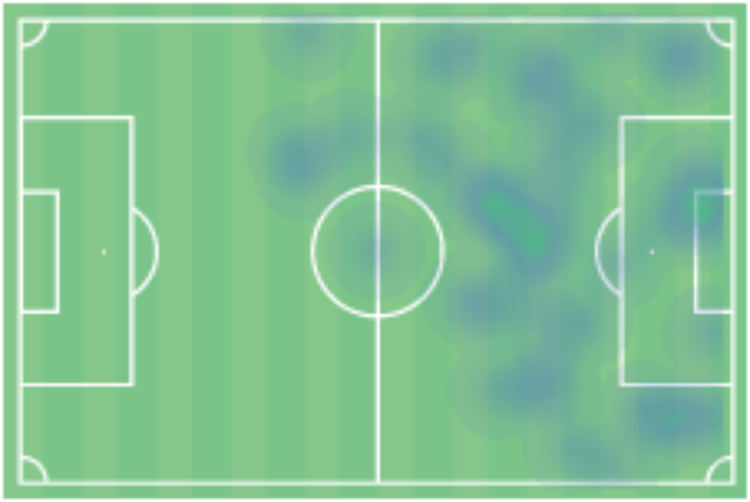
Even though Tirol clearly favoured long passes towards Maierhofer, it was still important that Dedič provided them in some situations like in the one below, at least an additional option how to get forward. Besides, since Admira occasionally gave away too much space between the lines, this pattern was quite effective.
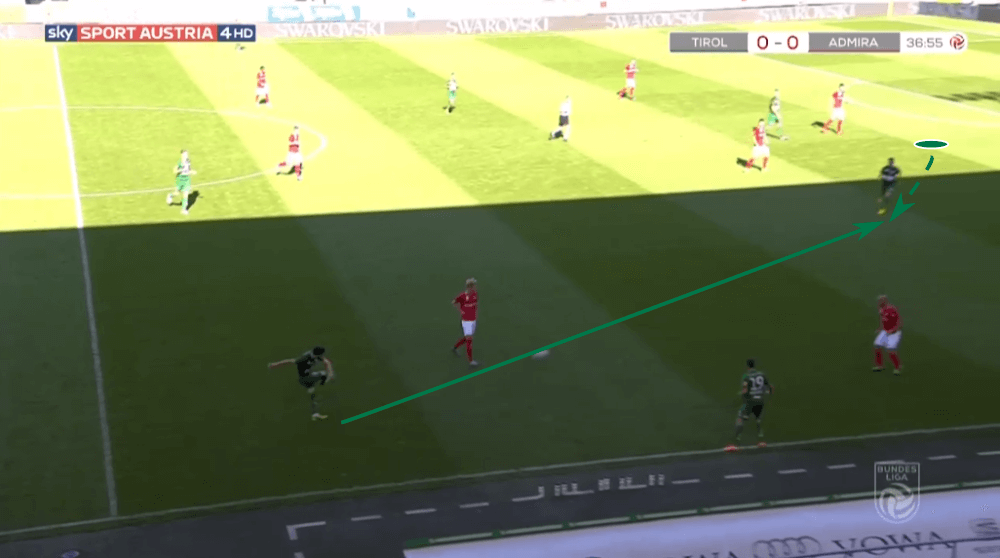
Both strikers performed quite well in this game and the tactical concept of Silberberger worked off as they had several good chances, but they didn’t convert them into goals and especially Maierhofer missed great chances.
Why Admira were so harmless
In the final part of this tactical analysis, we will look at the offensive tactics of Admira and explain why they were that harmless. First of all, we saw that Admira weren’t that offensive-minded as their opposition as they knew that a draw would be enough for them to stay in the league.
Still, they showed some decent football as they did throughout the season on occasions. They had several situations in which they overloaded one wing to then have enough options for a combination of passes, to lure the opposition to that wing before they then played the switch to the other side. Below we can see an example in which they did exactly this. Notice how many men they have on the right side as they then easily have a little passing combination to play moments later the ball over to the left centre-back, Aiwu.
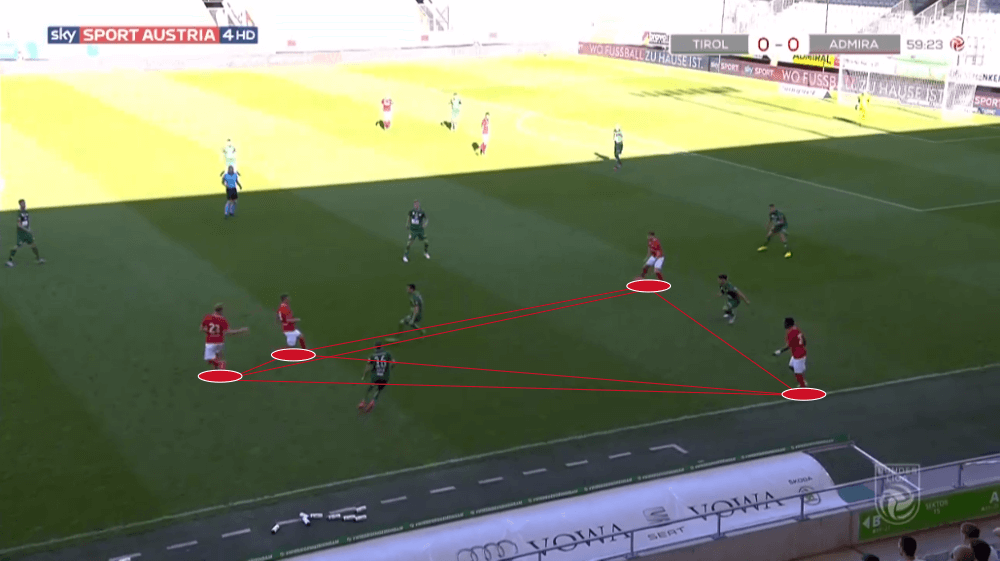
However, overall the team of Soldo seemed in some situations not that brave and they didn’t want to risk to lose the ball during the build-up and due to that, they worked with a lot of long balls. But firstly, Soares won most of his aerial duels against Admira’s striker, Pink. Secondly, Soldo didn’t push that many players forward to have enough defensive cover and due to that WSG Tirol won the majority of the second balls. Notice below how far away the players of Admira are to win the second ball and that Tirol have a clear numerical advantage in the marked area where the ball will likely go down.
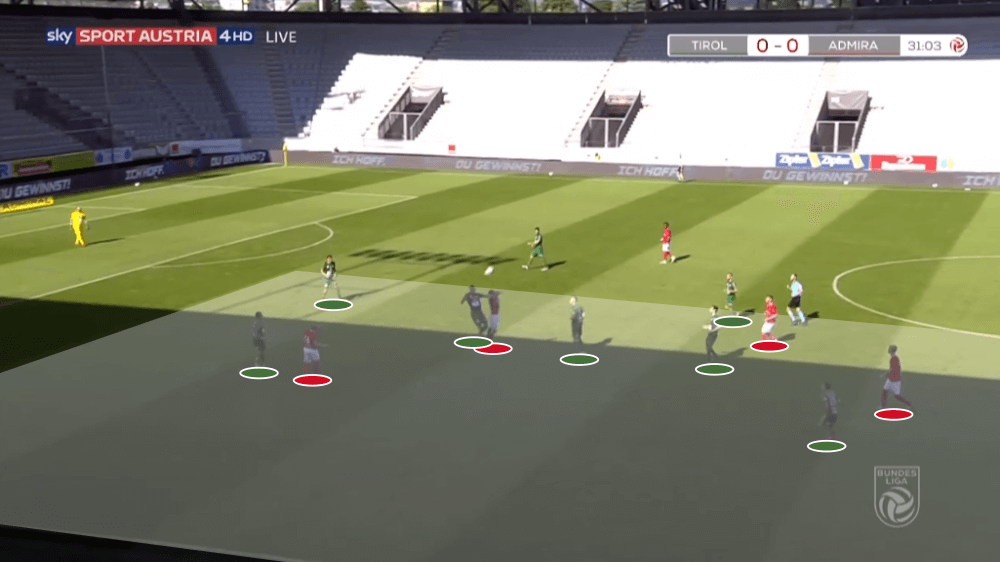
But we still have to mention that Admira had their chances to score at least one goa. Their two greatest goalscoring opportunities resulted out of diagonal balls towards Hoffer, with which they exploited the bad defending of Tirol’s right-back Neurauter. Below we can see the situation which led to the second great chance of Admira in this game (while the first one resulted out of a similar pass towards Hoffer.) The Austrian winger starts his run from a wider position diagonally into the centre to be out of the sight of Neurauter and then he controls the ball perfectly with his chest.
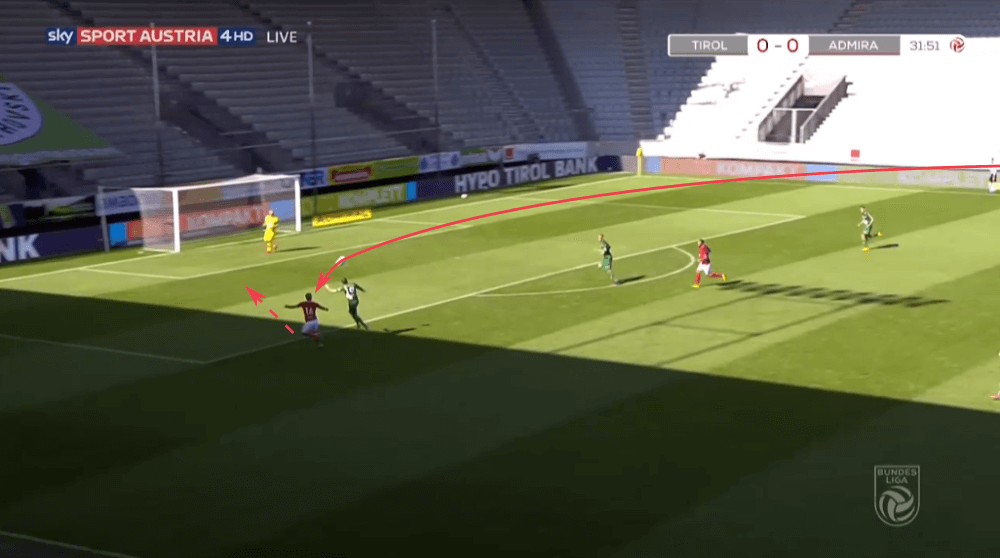
Conclusion
All in all, Tirol would have deserved the win more as they had slightly more goalscoring chances but on the other side, Hoffer was twice after the above-mentioned diagonal balls alone in front of Oswald, but couldn’t score either time.
We saw that WSG Tirol had a strict plan which they followed, while Admira focused more on the defending and didn’t send too many players forward. Due to that, Pink was often alone or had at the maximum only the two wingers with him, and due to that they rarely created something out of their long balls.
Still, WSG Tirol will be relegated to the second Austrian division as they collected fewer points than any other team in the Austrian Bundesliga. Meanwhile Austria Klagenfurt and Ried fight in the second tier for the first position which would put them back into the top division.





Comments